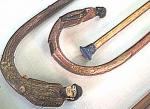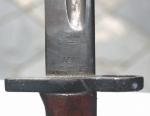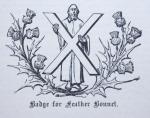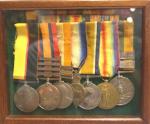-
Posts
13,225 -
Joined
-
Last visited
-
Days Won
22
Content Type
Profiles
Forums
Blogs
Gallery
Events
Store
Everything posted by Mervyn Mitton
-

Walking Sticks - and as Weapons
Mervyn Mitton replied to Mervyn Mitton's topic in Non Military Collectibles & Antiques
With the handle closed - making a proper hand grip. The round object unscrews and is re-screwed to the bottom to prevent the stick sinking in mud. CLICK TO ENLARGE -

Walking Sticks - and as Weapons
Mervyn Mitton replied to Mervyn Mitton's topic in Non Military Collectibles & Antiques
This is still a stick - but is known as a shooting stick. In the 18th and 19th Centuries Gentlemen would spend the day shooting Pheasants (and probably peasants if they got in the way ) Your bearers stood behind you loading your shotguns and you sat on the opened 'shooting stick'. Your locals 'beat' the bush to drive the birds to with-in easy shot. This type of portable seat was also useful at sporting events and today, they are very sought after. CLICK TO ENLARGE -

Walking Sticks - and as Weapons
Mervyn Mitton replied to Mervyn Mitton's topic in Non Military Collectibles & Antiques
Chris do you have any example to show - perhaps Ulsterman may have ? Mervyn -

Walking Sticks - and as Weapons
Mervyn Mitton replied to Mervyn Mitton's topic in Non Military Collectibles & Antiques
-

Walking Sticks - and as Weapons
Mervyn Mitton replied to Mervyn Mitton's topic in Non Military Collectibles & Antiques
Two good examples of modern walking sticks - but based on much earlier designs. These came from Tanzania and are made from Ebony - the beautiful black wood that has now become quite rare. It is one of several woods that will not float - including Teak and Lignum Vitae. The white tops are Hippopotamus tusks. CLICK TO ENLARGE -

Walking Sticks - and as Weapons
Mervyn Mitton replied to Mervyn Mitton's topic in Non Military Collectibles & Antiques
This statue from the Cairo Museum clearly shows Tutankhamon carrying a long wand of office. Additionally, he is holding a wooden and gilded Mace. Not dis-similar from our Ceremonial Maces from 5000 years later. CLICK TO ENLARGE -

Walking Sticks - and as Weapons
Mervyn Mitton replied to Mervyn Mitton's topic in Non Military Collectibles & Antiques
Over 130 walking sticks - for different purposes - were found in the tomb of Pharoah Tutankhamon. More gilding , but not greatly different to those 5,000 years later. CLICK TO ENLARGE -

Walking Sticks - and as Weapons
Mervyn Mitton posted a topic in Non Military Collectibles & Antiques
Even before weapons evolved with our ancestors, little ape like creatures probably helped to support themselves on two legs with the help of a stick. So, in all probability a stick is mans' earliest tool. This has continued to evolve over tens of thousands of years - through spears, cudgels, daggers with points - right down to the Victorian Gentleman's walking stick - so necessary for social status. Walking sticks still play an important part in 21st. Century life - for the disabled - for the elderly - and for a help up steep hills when taking the dog for a walk. There are also many Continents where a stick can be essential to guard against snakes - Africa, Australia ans South America come to mind. Very early on sticks became decorated and elaborated-on to show a person's status. The early Sumerians and their period - some 8,000 years ago - were probably the forerunners of sticks as emblems of office. Closely followed by the Egyptians. The Museums in Egypt show many styles and purposes for sticks or, wands of office. Very many were found in the Boy Pharoah Tutankhamon's tomb - and each was used for a different purpose and a different ceremonial occasion. Their purpose may have varied over the generations - but the generic styles did not. One of the reasons for a member of nobility to carry a stick, was that it showed he was just that - a nobleman who did not work with his hands. Also, it never hurt that you held a weapon in your hand at all times. By the 16th and 17th. Centuries there were a number of refined uses for sticks which represented Authority. Tipstaffs are a perfect example - the bearer of one could have people arrested and often seize property. Another example - from a later period - would be Black Rod - carried in the British Houses of Parliament. The simple fact is that in homes all over the World, there are walking sticks standing in halls and by doors. This makes it a perfect article for our member's to submit examples that they have in their families. I will be showing some pieces that I own - and will also show a number from earlier periods. ADD YOURS ? -
Under our section - Guests Valuations and Identifications - there is an interesting lapel pin. I think it may have a Masonic background and would be grateful if you could look to help our guest. Mervyn
-

Exceptional 7 Bar Group
Mervyn Mitton replied to Mervyn Mitton's topic in Great Britain: Orders, Gallantry, Campaign Medals
Mark - thankyou for that correction. I had intended to say Cameron Highlanders - but confused myself ! I will not correct the entries at this time - your posting is a good example of how easy it is to make mistakes with British. Regts.. -

Old Swastika Brooch
Mervyn Mitton replied to Robin Lumsden's topic in Non Military Collectibles & Antiques
You have my deepest sympathy ! Mervyn -

1907 Lee Enfield - Again .............
Mervyn Mitton replied to Mervyn Mitton's topic in Swords & Edged Weapons
-
These days one of the most often shown bayonets is the .303 Lee Enfield. There is a reason for this - they were the 1st World War bayonet - and most have a date from this period. They also continued to see World Wide service until the shorter version was introduced for WW2. The only reason i'm showing another one , is because of the attractive way it has been mounted and preserved. They are getting harder to find in good condition and prices have gone up accordingly. This one has a cut-out of a varnished plywood behind the hilt and scabbard and has been given an overall coat of a thin varnish. This could be easily cleaned-off, but has preserved the leather. I think this simple mount would look good on any wall. CLICK TO ENLARGE
-

Old Swastika Brooch
Mervyn Mitton replied to Robin Lumsden's topic in Non Military Collectibles & Antiques
Robin - an early and interesting piece - and in exceptional condition. Did you source this in Britain ? The Celts were active until about the 6th and 7th. Centuries. My lot - The Angles then invaded - folllowed by the Saxons. The last remaing Celtic outposts are Wales, Cornwall and Brittany. I don't have to remind you with your background, that many of these are now found with metal detectors. Which has created another layer of regs. and questions. Thankyou for supporting this non-militaria site - I think it is beginning to gain more interest, as members' realise just how wide the subject base is. Mervyn -

Exceptional 7 Bar Group
Mervyn Mitton replied to Mervyn Mitton's topic in Great Britain: Orders, Gallantry, Campaign Medals
Congratulations Will. We will want lots of pictures - including you wearing it ! Will you need to have S.A. Govt. approval for wearing-it ? Thankyou for the extra local knowledge. -

Exceptional 7 Bar Group
Mervyn Mitton replied to Mervyn Mitton's topic in Great Britain: Orders, Gallantry, Campaign Medals
Mike - I'm having papers drawn - will let you know. He may not have had enough time ? -

Exceptional 7 Bar Group
Mervyn Mitton replied to Mervyn Mitton's topic in Great Britain: Orders, Gallantry, Campaign Medals
CLICK TO ENLARGE The Badge of the Cameronians. I do have photos showing the naming for these - probably easier if I list each campaign and his rank. SUDAN - Private. Cameronians. QSA & KSA - Corporal. Cameronians 1915 Star. - Squadron Sergeant Major. Botha's Mounted Rifles. German South West Africa. War & Victory. - Sergeant Major. South Africa Service Corps. He died about 20 years ago - in his 90's. -

Exceptional 7 Bar Group
Mervyn Mitton replied to Mervyn Mitton's topic in Great Britain: Orders, Gallantry, Campaign Medals
The Bars on the Khedive's Medal - which is , of course, mounted after British Medals. CLICK TO ENLARGE -

Exceptional 7 Bar Group
Mervyn Mitton replied to Mervyn Mitton's topic in Great Britain: Orders, Gallantry, Campaign Medals
-

Exceptional 7 Bar Group
Mervyn Mitton replied to Mervyn Mitton's topic in Great Britain: Orders, Gallantry, Campaign Medals
-

Exceptional 7 Bar Group
Mervyn Mitton replied to Mervyn Mitton's topic in Great Britain: Orders, Gallantry, Campaign Medals
This shows the Group opened out for viewing. Like a lot of old soldiers he didn't have new medals remounted. Rather just kept adding to the bar. This is a 5 bar with 7 medals. CLICK TO ENLARGE -

Exceptional 7 Bar Group
Mervyn Mitton replied to Mervyn Mitton's topic in Great Britain: Orders, Gallantry, Campaign Medals
Sudan has always been a difficult place to administer - particularly since it was under Egyptian rule. Every foreigner to a Sudanese was known as a 'Turk'. In 1882 the Egyptian Governement sent an army of 10,000 men under Hicks Pasha to restore order - this walked right into an ambush and all were slaughtered. General Gordon was asked to return to Khartoum - capital of Sudan - as Governor General, to try and bring back peace - however, it was not to be. A Mahdi of great power had taken control, Mahomed had gathered a large army and Gordon's forces were totally inadequate. Mahdi's had risen in the past - the title means interpreter - or, go-between for Moslems. However, this had become something on a much greater scale. Despite the efforts of the British to reach Khartoum and save Gordon, it was not to be. He died on the steps of his HQ - and I have actually seen the remains - I understand that it has now been destroyed, but Will can tell us ? The result of this was that Britain retreated and the Mahdi and his men remained in control. However, the wealth of Sudan was needed by Egypt and in 1897 four British Regiments , a fleet of river boats and a large number of Egyptians, advanced into Sudan. One of the British Regiments was the famous Cameronians - the only single battalion Regiment in the Army, until 1897 when a second battalion was formed. Lord Kitchener was the Commanding General and his plans were well thought out. The first encounter was the Mahdist fort at The Atbara. This was a massive fortress and and a solid barrier to the advance on Khartoum. The Fort was stormed and captured and after re-organising, the Army continued it's advance on Khartoum. Strangely, the British Medal was not given Bars - however, the Khedive's silver medal given to British troops does have bars. These are shown for this group as The Atbara and Khartoum. However , this is how the Egyptians knew the City. The actual battle was fought at Omdurman - which is on the opposite bank from Khartoum. After Omdurman the Mahdist threat ceased to exist - although, in following years others did attempt new uprisings - by then we had a simple solution - we executed them before they got out of control. I will deal with the Boer War pair and the WW1 trio as we go through the medals. -
This splendid group has medals from three wars. Sudan - Boer War - and WW1. The medals are from left : The Queen's Sudan Medal ; Queen's South Africa Medal : King's South Africa Medal ; WW1 Star ; War Medal ; Victory Medal ; Khedives Medal for Sudan. I will go into further detail lower down. CLICK TO ENLARGE
-

dating please
Mervyn Mitton replied to blueman's topic in Great Britain: Militaria: Badges, Uniforms & Equipment
There has been an interesting post under Visitor's Questions - which I let continue on Members' Identifications. It involved two Crowns - with a red backing - mounted on a strange brass plate. The poster found it on the banks of a stream in Maine , US. Should any of you have time, please read the two sets of posts and give your opinion. Bear in mind that until the 1870's we only had King Edward's Crown. This tended to be rounded for the Georges - angular sides for William 4th. For Queen Victoria , Hers started quite angular but, later became more rounded. -
Nicely carved piece Robin. I would think it originally formed part of a commemorative box. Do you have any ideas on origin ? These pieces have always been popular collectibles - the problem was Queen Victoria - who had everyone carrying bits of their loved ones around in lockets etc..
















